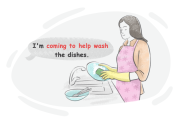Catenative Verbs
This lesson delves into the complexities of catenative verbs, exploring their roles in chaining verbs in different grammatical structures and contexts. It offers comprehensive explanations, advanced exercises, and a quiz.

What Are Catenative Verbs?
Catenative verbs (also known as chain verbs) link with other verbs and form a chain of two or more verbs. Any main verb (not auxiliary or modal verbs) that can be followed by another main verb is a catenative verb.
Catenative Verbs: Complements
Catenative verbs take non-finite clauses as their complement:
Take a look at an example:
I want to dance.
Tip!
Theoretically, multiple catenative verbs can come in one chain.
He decided to agree to start learning to bake German pastries.
Catenative Verb Complement: To-infinitives
Many catenative verbs can be followed by a to-infinitive, such as:
agree
want
ask
decide
demand
choose
dare
expect
hope
happen
Take a look at some examples:
He expects to complete the project in June.
We agreed to meet the following day.
I chose to learn Spanish rather than French.


Catenative Verb Complement: Bare Infinitives
A limited number of catenative verbs can be followed by bare infinitives, such as:
make
help
let
see
feel
hear
watch
have
I learned that you just have to let go sometimes.
I'm coming to help wash the dishes.
He didn't have any money so he just had to make do.
Catenative Verb Complement: Present Participles
Many catenative verbs can be followed by the present participle, such as:
go
suggest
admit
stop
avoid
consider
help
enjoy
look forward to
mention
I couldn't help thinking about that night.
The bullet went flying over my head.
I stopped smoking and looked at him.
Catenative Verbs + To-infinitive or Present Participle
Some catenative verbs can be followed by the to-infinitive or the present participle. Sometimes there is a change in meaning, sometimes not.
Verbs with no significant change in meaning:
love
start
begin
continue
hate
prefer
like
They continued working on the project. = They continued to work on the project.
I love hanging out with you. = I love to hang out with you.
Verbs with significant change in meaning:
try
stop
remember
regret
go on
come
I stopped smoking. ≠ I stopped to smoke.
I remembered to say goodbye. ≠ I remember saying goodbye.
Catenative Verb Complement: Past Participles
A limited number of catenative verbs can be followed by the past participle:
Get lost!
I had my car fixed.
False Catenatives
Every verb following another verb cannot automatically be considered a catenative structure. Let's see some examples:
He trained to improve his performance. = He trained in order to improve his performance.
Here, 'to improve' is an infinitive of purpose, rather than a to-infinitive that serves as the complement of a catenative verb.
I stopped to buy some fruit. = I stopped in order to buy some fruit.
Complex Catenative Structure
If a catenative verb has an object, usually the object comes between the catenative verb and the second verb. It is still considered to be a catenative structure, for example:
He wants me to try harder.
In this sentence, the object 'me' is placed between the catenative verb 'wants' and the to-infinitive verb, 'to try'.
I prefer you to wear clean clothes all the time.
The object can sometimes be in the form of an object of preposition.
I count on you to finish this.
He arranged for the car to be repaired.
Review
Catenative verbs are verbs that work as a chain. They follow each other to make meaningful sentences. Verbs that can follow a catenative verb in the set of verbs are:
to-infinitives
bare infinitives
present participles
past participles
Quiz:
Arrange the words to form correct sentences using catenative verbs.
Match each catenative verb with its correct complement type.
Complete each sentence with the correct form of the verb in parentheses.
She decided
(study) abroad next year.
They let us
(leave) early yesterday.
I enjoy
(read) novels in my free time.
We hope
(visit) Japan next summer.
He had his suit
(clean) for the wedding.
Which sentence is NOT a true catenative structure?
He tried to win the race.
She let him borrow the book.
I stopped to buy coffee.
They began to discuss the plan.
Identify the sentence that correctly uses an object of preposition in a catenative structure.
He made the children clean the room.
They told to us to wait here.
They arranged for the meeting to start early.
She wants for me helping her.
Comments
(0)